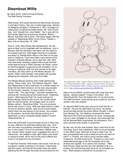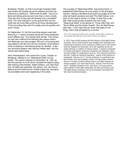

Walt Disney, who would become the best-known producer in animation history, had very humble beginnings. Starting his fledgling company in Hollywood in 1923, he began by making two uninspired animated series, the “Alice Comedies,” and “Oswald the Lucky Rabbit.” But it was with his third series, featuring an enduring character, Mickey Mouse, that Walt rose to fame. That series began with the release of "Steamboat Willie" at the Colony Theater in New York on November 18, 1928.
Early in 1928, Walt Disney was disheartened. He had gone to New York to negotiate with his distributor, only to discover that the distributor had taken over the rights to his Oswald cartoons. Walt began thinking of a possible successor to Oswald while riding on the train on his way back to California. There have been many stories of the inception of Mickey Mouse, but on that train ride, Walt may have been recalling a playful little mouse that had made itself at home in Walt’s Kansas City Studio, where he had first started to experiment with animation. On returning to California, Walt met with several of his staff members, and they came up with Mickey Mouse. Ub Iwerks, Walt’s chief animator, was tasked with actually designing the character, with input from Walt.
Two Mickey Mouse cartoons were made starting that spring, “Plane Crazy” and “The Gallopin’ Gaucho.” Walt tried desperately to sell a distributor on a series based on those first two silent cartoons, but he was unsuccessful. On the horizon, however, he saw a flicker of hope. Al Jolson’s film, “The Jazz Singer,” had been released the previous fall, introducing synchronized sound. Audiences loved it. Walt reasoned that if he could produce his Mickey Mouse cartoons with sound, the novelty would help him sell the series. So he began work on a third Mickey cartoon, “Steamboat Willie,” this one produced strictly with sound in mind. Walt was determined to make his sound cartoons realistic; each sound would exactly match what one was seeing on the screen. As a subject for the cartoon, he would have Mickey working on a steamboat, a nod to comedian Buster Keaton’s recent “Steamboat Bill, Jr.”
[…]